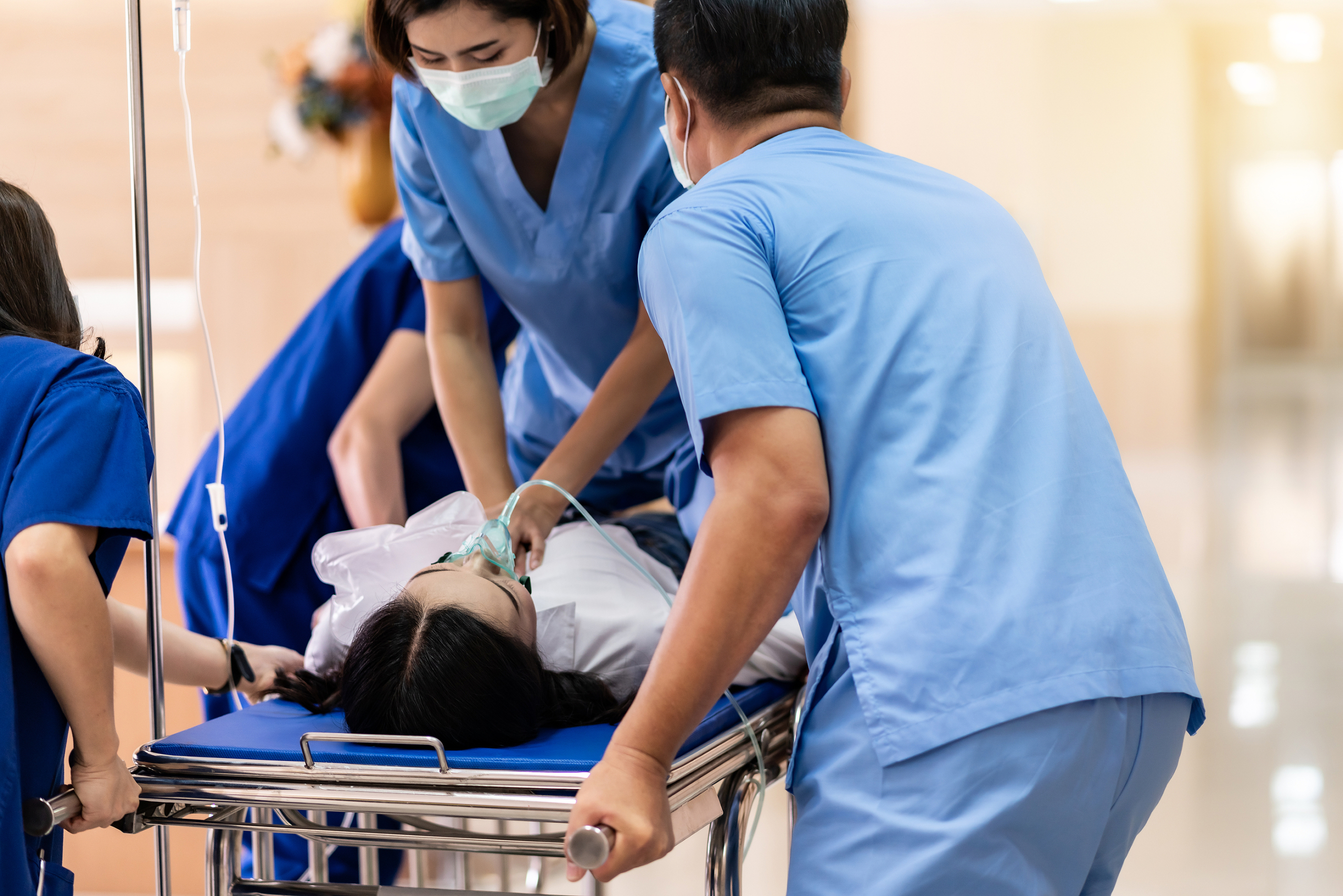Newsletter 2021
Resident Corner - An interesting case of a sizeable adrenal incidentaloma resection in a 26-weeks parturient
Tzima M, Georgopoulou E, Mavropoulos C, Tsakyridou E, Katsanoulas K, Katsika E
Hippokrateion General Hospital, Thessaloniki, Greece
martzi88@yahoo.gr

The case
A 26-year-old parturient is hospitalised for a sizeable mass resection, found in the Morrison’s pouch. She has been admitted to the hospital due to a fainting episode. The woman has been complaining of continual pain in the right upper quadrant. After rigorous examination and imaging, an adrenal mass, which showed a rim of acute haemorrhage signal, in the right subhepatic space was found, and resection was decided due to its big size (8,75x 9,26×11,5cm), the possibility of new bleeding and the up growing uterus pressure on it. The mass was not hormone-secreting.
The woman is in the 26th week of gestation, with no comorbidities, she is a social smoker and receives only folic acid and iron supplements. Her laboratory tests are in normal ranges and her BMI is 21,4. Clinical examination of the respiratory and cardiovascular systems was normal. Monitoring of depth of anaesthesia (PSI: Masimo Corp., Irvine, CA), cerebral oximetry (rSO3: Masimo Corp., Irvine, CA) and analgesia nociception index(ANI: Mdoloris Medical Systems, Loos, France), which shows a preponderance over sympathetic action through heart rate variability, were placed for better management of drugs and the best outcome. Cardiac index (CI) and SVV were measured with ProAQT/Pulsioflex (PULSION Medical Systems, Feldkirchen, Germany). An epidural catheter was placed in the L1-L2 space. She was placed in a left lateral position with inclination, to avoid inferior vena cava syndrome. Fetal heart rate was monitored before surgery. After induction with fentanyl 2mcg/kg, propofol 3mg/kg and rocuronium 1mg/kg and a successful intubation, dexamethasone 8mg, omeprazole 40mg and remifentanil 0,1mcg/kg/min, sevoflurane 2%, with a PSI of 25, were administered. Her blood pressure dropped 15% right after induction and was treated with ephedrine 10mg and remained stable at the initial ranges all through the surgery (110/60mmHg). CI was 2,89-4,29 and SVV 5-15%. rSO3 remained stable 58-66 left and 65-73 right hemisphere. The epidural analgesia infusion of 0,1% ropivacaine started before awakeness, along with 5mg Morphine, 1g paracetamol and 4 mg ondasetrone and individualised opioid-sparing were performed with an ANI raising up to 100, from 70 during operation. Total blood loss reached 700ml. 200mg sugammadex was administered and the parturient recovered uneventfully well with a normal NST (non-stress test), normal fetal heart rate and no uterine contractions. Histopathology revealed an adrenocortical adenoma. She is now in the 31st week of gestation and her pregnancy is uncomplicated.
Discussions
This challenging case was of great educational value. The main concern of surgery during pregnancy are drug-related teratogenic effects, malformations, fetal death and preterm labour. Furthermore, there is a fear of neurodevelopmental and behavioural problems. Concerning pharmacokinetics, various changes are observed. Due to increased CO, absorption from mucous membranes and skin is enhanced. FRC is reduced and MV is increased, so pulmonary uptake of inhalational anaesthetics is faster. The most important change is protein-binding, due to an important reduction in plasma albumin levels, so the concentration of free drugs is increased. Another thing that is of great value, is the fetal-maternal distribution. The fetal albumin concentration is slightly higher and fetal PH is more acidotic than the maternal one, a fact that may increase the fetal concentration of some drugs. Endogenous opioids, i.e. endorphins and progesterone, may increase pain threshold, enhance sedation and nociception, that is why maternal anaesthetic requirements are reduced during pregnancy. Operation during pregnancy has an incidence of 0,3-2,2% and the reasons may be obstetric (cervix cerclage, ovarian cyst, fetal abnormalities) or non-obstetric (trauma, malignancies, acute abdominal issues). The risks may have to do with the parturient and include wound infection, haemorrhage, respiratory issues, transfusion, venous thromboembolism and with the fetus, such as preterm labour, uteroplacental circulation, placental perturbation.
On the other hand, adrenal disorders, including adrenal masses, in pregnancy are extremely rare, but are of critical importance, as they increase fetal and maternal morbidity and mortality. Adrenal incidentalomas are extremely rare, due to restricted imaging during pregnancy. The main concern is hypersecretion of catecholamines and unregulated hypertension, which may affect so the mother, as the fetus. Adrenal hematoma is also a rare condition, 0,3-1,8% with an overall mortality of 15%, the incidence in pregnancy is unknown though. It may happen due to vascular rupture, central venous thrombosis, in terms of high arterial blood supply. Factors that may be related to adrenal hyperperfusion are high blood pressure, masses, coagulopathies, use of anticoagulants, lupus anticoagulants, antiphospholipid antibodies, adrenal hyperplasia, trauma. Pregnancy-related factors include preeclampsia, abortion, pre or postpartum haemorrhage. The decision for adrenal resection depends on the possibility of an upcoming haemorrhagic shock, or adrenal insufficiency. The therapy may be surgical or conservative. There are only a few cases all described, a fact that renders the management of such cases difficult.
References
- Gupta SR, Ghayee HK.. AACE Clin Case Rep. 2020 Dec 28;7(1):72-74. doi: 10.1016/j.aace.2020.11.020.
- Eschler DC, Kogekar N, Pessah-Pollack R. Endocrinol Metab Clin North Am. 2015 Jun;44(2):381-97. doi: 10.1016/j.ecl.2015.02.006
- Phoon JW, Kanalingam D, Chua HL. Singapore Med J. 2013 Jul;54(7):e141-5. doi: 10.11622/smedj.2013068
- Abdelmannan D, Aron DC.. Endocrinol Metab Clin North Am. 2011 Dec;40(4):779-94. doi: 10.1016/j.ecl.2011.09.001
- Kamoun M, Mnif MF, Charfi N, et al, Am J Med Sci. 2014 Jan;347(1):64-73. doi: 10.1097/MAJ.0b013e31828aaeee.
- Harrington JL, Farley DR, van Heerden JA, et al,. World J Surg. 1999 Feb;23(2):182-6. doi: 10.1007/pl00013159.
- Yang L, Zhu YC, Liu RB. Medicine (Baltimore). 2018 Nov;97(47):e13329. doi: 10.1097/MD.0000000000013329.
- Anagnostopoulos A, Sharma S.. BMJ Case Rep. 2011;2011:bcr0720114496.
- Tritos N, , Medscape, Updated: Aug 25, 2020
- Chestnut’s Obstetric Anesthesia, Principles and Practice, 6th edition:14;313-335
Read our Monthly newsletter.
Read More of our special newsletter covering our virtual congress 2020.
Visit our COVID-19 Resource Hub for other news and resources.










